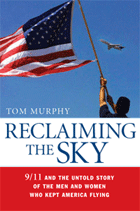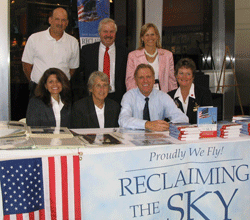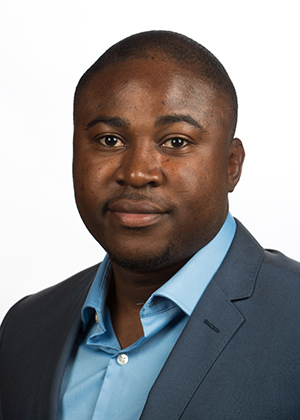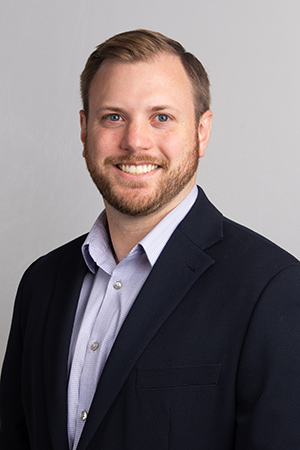Register

|
|||||||||||||||||||||||
|
|||||||||||||||||||||||
|
|||||||||||||||||||||||
2023 "Reclaiming the Sky" Winning Stories
First Place Michael Gyan
Employer: John C. Munro Hamilton Int'l Airport, Ontario, Canada
The event of 9/11 was as much a local disaster as it was a wake-up call for global and national security. As recounted by a plethora of personalities in the book, the collapse of a nation was eminent, yet the people rose to the occasion and were united in their efforts to reclaim lost ground. Throughout the book, time was a reoccurring theme, presenting a strong understanding of the experiences shared among the characters. The lessons learned with the idea of time and action in mind represent the 'now', 'after', and 'forever'. September 11th, 2001, a day that started out like any other, soon turned out to be the most terrifying nightmare. This statement could not be any truer for a man like John Duval. From a young age, John adopted a routine that helped him rise to the top: come early, stay late. This drive perfectly expresses the commitment and attention to detail John shows in his work. Incidentally, when John heard about the attack on the World Trade Centre, it came as a shock to him that such an attack could have occurred under his supervision. His immediate response was to rely on a connection and a good friend, Ed Freni, former station manager of American Airlines in Boston and Logan Airport Director of Operations on 9/11, for more information about the incidents. The unity between these two men in such a chaotic time exemplifies the heart of the human experience, the very thing that will keep us resilient during such atrocities. In the account of Sue, the initial shock was felt by all, as if the world stood still. The emotion that followed the first crash was a brazen rush of adrenaline felt city-wide. The panic was beyond control; paramedics and fire crew scrambled to the scene; pedestrians hurried off the scene in search of shelter. Yet, there was one odd one out; one cog in motion while the others remained still, Sue Baer. During the chaos, she was searching for avenues of support that she could relay to others like it was second nature. In moments of pressure and tragedy, she could have stayed still and in shock like others. Rather, she set an example and was a beacon of hope. The aftermath of such an event needs to be acknowledged, but we cannot allow ourselves to remain in the past forever. Some say, "time heals", well in this case, time proves our humanity; the undying passion to rise above our challenges and discover new heights. Following Sue's acts, we are reminded of the importance of togetherness, trust, and responsibility. Your airport community is important; for an airport to work, you must trust and work in your community. Initiative and proactivity should be second nature. Recounting Port Authority Police Officer Tom Innace's story, there are semblances of Sue. Time being a major theme in his perspective, he is asked "where do you find the strength?" What did you learn from this incident? In similar fashion, he believes time heals and that by working, he finds a reason to live for the heroes who altruistically became martyrs. He is reminded by the "pile" on his way to work, a daily reminder of the events before, during, and after the crash. It is the collection of all the good and bad experiences on that day. However, as he reaffirmed, it is up to the person to understand and to take from what happened, using it as a learning moment to bolster their motivations in life. Sure, one can remain in a mournful state due to the depressing perspectives, but we cannot dwell on it forever. Time waits for no man, as such, we must stay in the present and learn from our past. As we seek to replicate the altruism of the heroes, we should not forget to live in the moment while looking toward tomorrow. In my role as a Project Manager, I work together with many departments, stakeholders, and contractors, and I have learned that it is critical to build ongoing and dependable relationships with my community as we need each other in our resiliency against the fear of terrorism, stresses of life and setbacks. Second Place Salvatore Mendola
Employer: Areas, USA. Miami, Florida
Stress. Anxiety. Our response to these two terrifying and common nouns can determine who we are as individuals and ultimately, our legacy. Decisions that we make under duress in the workplace can catapult our careers or send them spiraling in the opposite direction. We've all gone through trials and tribulations where we've had to act with a swift response and firm conviction. However, the magnitude of those challenges doesn't cast a shadow on those confronted by Sue Baer on September 11th, 2001. As the first woman to manage the Lincoln Tunnel and the first female director of an airport at the Port Authority of New York and New Jersey, Sue was no stranger to adversity. Throughout her career, she made decisions that felt "right" instead of yielding to the easy route. Whether selecting Barnard College over Penn State or taking the challenge of becoming the youngest director of a department at the Port Authority, she refused to shy away from the "safe" route. To shatter the glass ceiling, Sue had to overcome the odds stacked against her daily. Not only did she do so, but with such grace, intelligence and professionalism that earned her the respect of all those she encountered. This prepared Ms. Baer to demonstrate bravery and mental fortitude that many would not be able to exhibit under such extreme circumstances. Had she not acted so quickly, the unbearable number of lives lost on September 11th could have been significantly higher. Balancing our professional and personal lives can be a daunting task. With a young child at home and a work environment that requires intense focus, no one knew this better than Ms. Baer. Her morning started with the most difficult anticipated tasks to be where to get bagels from and how to get her son to school. In the blink of an eye, her next tasks defined not only her career, but the safety of thousands of civilians. Amidst one of the deadliest attacks on United States soil, Sue could have folded. She could have panicked and not directed the managers to close the airport. She could have determined that she needed more information before making the decision for which the financial risk alone could end her career. Yet, after hearing the devastating news, she sprung to action and trusted her instincts. I've played sports my entire life and have had to perform at my peak during moments of physical fatigue and weakness. As I've grown older, the game has slowed down for me, allowing me to make smarter decisions and face adversity with swift action. When I make a mistake or am uncertain, my teammates are counting on me to use my experience and instinct to pull through when needed most. The playing field and work grounds are not all entirely different. Even when we don't initially succeed or we cannot think of the best solution to a challenge, our colleagues, like our teammates, depend on us to be resilient and put our best foot forward. The words that resonate with me from Sue regard grief: "find something you can do for somebody and do it. Nobody heals alone." This is a different type of resiliency. When we think of resiliency, it typically relates to mental or physical challenges. The ability to show empathy and think of others when tragedy strikes is a sign of true character and strong leadership. During difficult times, those struggling look for guidance and leadership. Like Sue, I want to be there emotionally, mentally and physically to lead others through adversity. Ms. Baer was a true hero whose story has taught me to stop, breathe, think and attack the problem. As life can change in an instant, her actions have inspired me to believe in my intuition and I can conquer any challenge presented. Heroes can emerge at any time and from any level – a testament to Sue's rising in the ranks. (Although she was already a leader in a high position.) Even being the one who brings the bagels to the meeting can save the world. Third Place Deborah Blass
Employer: Arup, San Francisco
Respect and inspiration to act; these are the two themes I keep coming back to when I reflect upon reading "Reclaiming the Sky." The respect feels more overpowering than any other impression. I am grateful for and humbled by all of those who chose to lead, chose to go back to work to do their job (and so quickly!) - amongst the extreme uncertainty, vulnerability, and chaos of 9/11. I am in awe of the leadership and support that was presented in the book by so many, whom, probably did not realize how impactful their decisions were at the time. This terrible part of history has, in-part, led me to my career as a physical security engineer, specializing in the design of buildings to be resilient to security threats and terrorism. It is a specialist field that was pioneered following the Oklahoma City bombing in 1995, and re-established with new meaning after 9/11. Since reading the book has inspired me to act, I was inspired to explore how my engineering designs of airports can better support operations teams face the next challenge – whatever that might be. It is currently good practice to incorporate resiliency into design – against earthquakes, power outages, terrorism, etc. – but the resiliency incorporated is typically based upon a past event. It is much more challenging to incorporate resilience for an unknown future incident. What do you design for, if you don't know what's coming next? In the immediate aftermath of 9/11, Sue Baer had three concerns: "first, secure the airside... ...Next, get people out of the terminals. Third... ...provide information." In reflection, I find these three actions could be applicable to many emergencies so I would like to explore how design can better support operations teams through these actions. Sue's direction to use the contractors' equipment to line barriers in front of the access gates was very resourceful and innovative. Being able to secure the airport quickly could be useful for all airports; operable barriers that can be raised from the ground with the push of a button could be built-in to an airport's perimeter design. And to improve resiliency, the airport might not want to solely rely on an electronic system, which could break-down. As a designer, I can provide physical spaces, or buildings, in convenient locations near the perimeter gates for storage of barriers and other emergency security equipment. The next concern Sue had was getting fifty-thousand people out of Newark airport. In the best case, the approach roadways were likely designed to accommodate the peak passenger flow expected at Newark under normal conditions, but understandably, not for the unexpected grounding of all planes. The book mentioned how some people tried walking the roadways to leave the airport; with all the people there could have been secondary injuries due to persons accidentally getting hit, or even worse injuries if the 50,000 hadn't remained calm. I, as a designer, should work in-combination with the airport operations team to ensure that there are wide-enough sidewalks (or as wide as feasible), enough roadway lanes, as well as spaces for staging areas for buses to accommodate safe evacuation. Sue's third concern was regarding communications. On 9/11, Sue's team used a conference room to create their emergency plan. Due to the major events of the day, the room did not have very effective communications systems. My designs can consider how to incorporate back-up and redundant infrastructure to equip rooms with internal and external communications systems. Beyond the opportunities I will explore for improving resiliency in my design work, I also learned an important lesson in leadership. The ability to "work in a fast-paced environment", "innovate", or "make decisions based on uncertain information", etc. are standard requirements for many jobs, but those qualities really get tested when dealing with an uncertain or emergency situation. When Sue and others faced unprecedented pressure and uncertainty, they continued to act - making decisions so the world can "soldier on", all while providing support and compassion for their teams. The immense respect I have for the way they led as described through their stories, has influenced my desire to develop into a compassionate, supportive leader.
|
|||||||||||||||||||||||
© Copyright 2005 Reclaiming The Sky dot com. All rights reserved. |
|||||||||||||||||||||||







